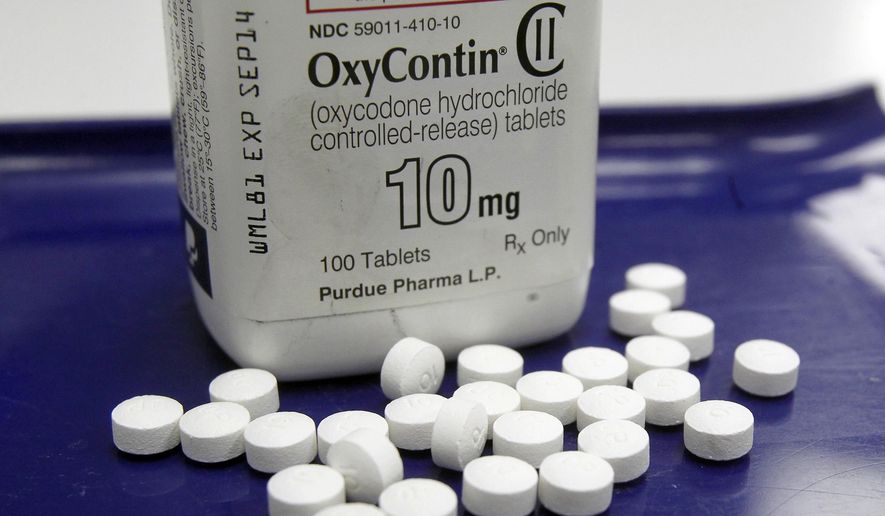The Veterans Affairs Department is doing a good job of slashing the use of opioids among veterans but is falling short on safety measures, such as checking whether patients have been prescribed addictive pills elsewhere, a government watchdog reported Tuesday.
The Government Accountability Office reviewed more than 100 veterans’ medical records at five VA facilities and found staff didn’t always adhere to policy guidelines or goals set forth in the agency’s five-year-old opioids program.
For instance, it looked at 53 veterans who were prescribed long-term opioid therapy, yet couldn’t find queries in state prescription monitoring program for three quarters of them. The databases are used to cross-check whether patients are getting multiple prescriptions from various sources, putting them at greater risk of overdose.
Investigators also said 21 of the veterans weren’t screened for drug levels in their urine within a year after receiving opioids. The screenings are used to make sure veterans are using their medications as prescribed.
The GAO also found a dozen veterans who hadn’t submitted “informed consent” forms, or acknowledgement they’d been educated on the risks and benefits of long-term opioid use.
More than 50 percent of veterans report suffering from chronic pain during primary care visits, so those returning from military service are considered a particularly vulnerable amid the U.S. prescription painkiller and heroin epidemic. The government says veterans are twice as likely to die from an accidental overdose when compared to the non-veteran population.
The VA launched an Opioid Safety Initiative (OSI) in 2013 to make sure veterans are prescribed opioids in a safe and effective manner.
Then, in 2016, Congress passed sweeping opioids legislation that requires the VA to report on its ability to meet goals set forth by the program.
The GAO says the VA is doing well overall —the percentage of veterans prescribed opioids dropped from 17 percent at the end of fiscal 2013 to about 10 percent last fall, or by about 267,000 veterans.
The agency is also meeting most of the OSI’s goals, though a lack of documentation made it difficult to tell if it was meeting all of its obligations, such as whether it was safely tapering veterans off opioids and benzodiazepines, a type of medication that is used to treat post-traumatic stress disorder.
Among its chief recommendations, the watchdog said the VA should make sure every facility has a “pain “champion” — an expert who advises doctors on how to reduce risks tied to opioid use. The GAO said four of the five facilities it reviewed didn’t have one.
It also said facilities could do a better job of reviewing veterans’ records to make sure their doctors are following safety guidelines.
“Without these efforts to improve adherence to key opioid risk mitigation strategies, VHA’s ability to ensure that all veterans are prescribed opioids in a safe and effective manner may be limited,” the GAO’s report said.
Sen. Johnny Isakson, Georgia Republican and chairman of the Committee on Veterans’ Affairs, noted the report comes on the heels of Memorial Day, in which Americans celebrated those who died in service of the nation.
“Unfortunately, too many of our brave veterans have been overprescribed opioids and have become dependent on them,” he said. “We must address this problem in a way that ensures the veteran gets the treatment he or she needs without the danger of becoming addicted due to overprescribing habits by VA doctors. I am pleased to see the VA is making progress in tackling the problem of over-prescription to ensure our veterans are protected. More work needs to be done, but this report shows that the VA is headed in the right direction.”
In response to the findings, the VA said it will establish a workgroup to review mandated yardsticks and make sure they have clearly defined goals and a timeline for meeting them; make better use of the data tools it has to track opioid treatment; and ensure that pain champions are used across the system.
It expects to implement these actions by April 2019, if not sooner, the report said.
Sen. Rob Portman, an Ohio Republican whose 2016 Comprehensive Addiction and Recovery Act called for GAO reporting, said his legislation appeared to be working as intended.
“CARA put in place stronger oversight and accountability for the quality of care we provide our veterans,” he said. “I’m pleased the VA is making strides but also acknowledged that more steps must be taken to ensure we provide the best care possible.”
• Tom Howell Jr. can be reached at thowell@washingtontimes.com.




Please read our comment policy before commenting.